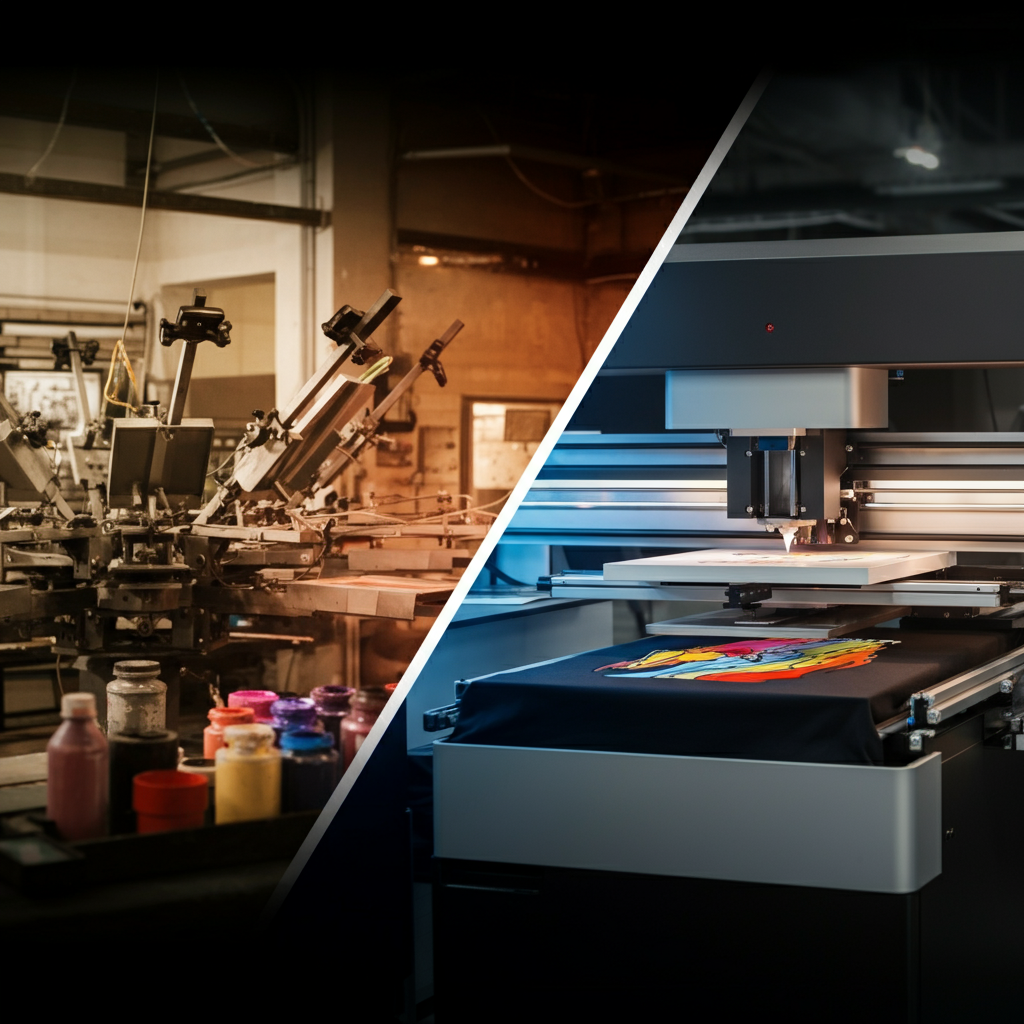Direct-to-Garment (DTG) printing and screen printing are two popular methods for creating custom apparel. Over the last few decades, DTG has evolved significantly to rival traditional screen printing in both quality and affordability. But if you’re considering custom apparel, which method is better for your needs?
The short answer? Both are excellent options. However, each technique has its pros and cons, making one more suitable than the other depending on factors like order size, design complexity, and fabric type. This guide will break down the key differences to help you decide the best fit for your custom printing needs.
What Is Screen Printing?
Screen printing, also known as silkscreen printing, is one of the oldest and most trusted methods for decorating apparel. This process involves creating stencils (screens) for each color in a design. The ink is pushed through the screens and layered onto the fabric before being cured with heat, making the design durable and vibrant.
Screen Printing in Action
Modern advances in screen printing technology allow companies to print over 100 T-shirts per hour using automatic machinery. At scale, screen printing is incredibly efficient, making it the top choice for high-volume orders. For example, every season, we produce tens of thousands of shirts for the Philadelphia 76ers within days.
When To Use Screen Printing
Screen printing shines in scenarios like:
- Large, high-volume orders that benefit from economies of scale.
- Unique or oversized print areas, where custom stencils provide full control.
- Single-color designs like text or logos that are easy and cost-effective to produce.
- Special effects and specialty inks, such as metallic or glitter finishes.
- Dark-colored fabrics, due to its highly opaque ink providing richer vibrancy.
- Branding projects that require exact color matching using Pantone colors.
What Is Direct-to-Garment (DTG) Printing?
DTG printing is a relatively newer method that uses an inkjet printer to spray water-based inks directly onto garments. Think of it as a high-tech home printer tuned specifically for textiles. It’s ideal for smaller orders and highly detailed designs, blending colors seamlessly.
Rising Popularity of DTG
Since its introduction nearly 20 years ago, DTG technology has continuously improved. State-of-the-art DTG machines are faster, more affordable, and capable of producing higher-resolution prints than ever before. Many on-demand printing companies now rely on this method for low-quantity orders without the setup costs of screen printing.
When To Use DTG Printing
DTG is the superior choice in cases like:
- Small or one-off orders where complex setup is unnecessary.
- Detailed designs with gradients or photographic elements.
- Cotton fabrics, as DTG inks bond best with natural fibers.
- Lightweight, soft-feel prints for comfort and wearability.
- Fast turnaround times needed for on-demand production.
Screen Printing vs. DTG Printing Comparison
Choosing between screen printing and DTG comes down to your specific needs. Below, we’ll compare the two methods across critical factors.
1. Vibrancy of Colors
- Winner: Screen Printing
Screen printing uses opaque Plastisol inks that create bold, saturated colors, especially on darker fabrics due to the ability to layer a solid white underbase. DTG, while improving in vibrancy, still falls slightly short when compared directly to screen printing. For a vintage or muted aesthetic, however, DTG can be a perfect fit.
2. Color Blending
- Winner: DTG Printing
DTG excels at achieving smooth gradients and photographic details thanks to its water-based inks and high-resolution printing capabilities. Screen printing can also blend colors but requires halftones, which demands more setup and may not deliver the same level of accuracy.
3. Color Matching
- Winner: Screen Printing
For precise Pantone color matching, nothing beats screen printing. DTG, restricted by the CMYK color model, struggles with out-of-gamut colors. If branding consistency is crucial, go with screen printing every time.
4. Detail Reproduction
- Winner: DTG Printing
Fine details like small text and intricate patterns are captured effortlessly by DTG printers, thanks to their ability to print at resolutions as high as 1200 DPI. Screen printing can handle details but requires adjustments to artwork and halftone techniques to achieve similar results.
Which Method Is Right for You?
When deciding between screen printing and DTG for custom apparel, consider these key questions:
- What’s the size of your order?
-
-
- Large? Choose screen printing.
- Small or single? Opt for DTG.
-
- What’s the design complexity?
-
-
- For vibrant, simple logos or text, go for screen printing.
- For multi-colored, detailed artwork, DTG is ideal.
-
- What fabric are you printing on?
-
-
- For cotton fabrics, both techniques work—but DTG thrives.
- For synthetic fabrics, stick with screen printing.
-
- Do you have color matching requirements?
-
-
- If consistent branding is essential, screen printing is the better choice.
-
Final Thoughts
Both DTG and screen printing can produce stunning custom apparel, but knowing the strengths of each is essential to achieving the perfect result. At [Your Business Name], we’re experts in both methods and are here to help you bring your vision to life.
Contact us today to discuss your project or get started on your design!

